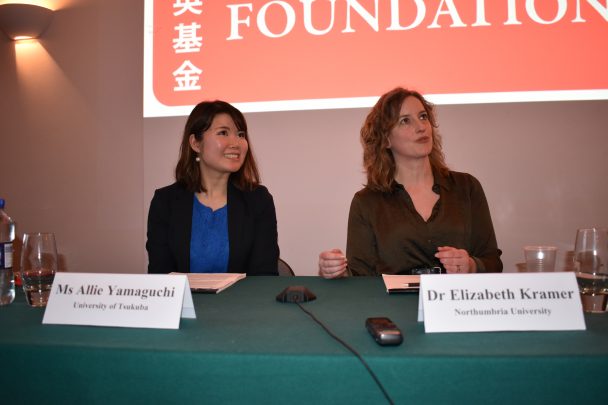 Talk
TalkMonday 9 April 2018
6:00pm – 7:00pm
Abandoning the Kimono
Drinks reception from 7:00pm
13/14 Cornwall Terrace, Outer Circle (entrance facing Regent's Park), London NW1 4QP
Organised by the Daiwa Anglo-Japanese Foundation
Fully bookedKimonos were among the most highly sought-after export wares produced for the Western market after Japan’s 200-year-long isolation policy ended in 1868, opening its ports to trade. In Britain, kimonos gradually became embedded in mainstream fashion from 1900 onwards. Kimonos were, then, very feminine, domestic garments normally worn indoors. Surviving kimonos from this period show British and Japanese cultural, political and industrial characteristics through each other’s eyes.
Conversely, British commentators disapproved of the Japanese adoption of European clothing and the perceived abandonment of the kimono. Although the adoption of European dress in Meiji Japan was intended to unite people during a period of rapid social transition and mark the country as an equal player on the world stage, this explanation was largely ignored by foreign observers. To Britain, the kimono symbolised a decorative and quaint culture – even childlike, or sensual and feminine, and in need of guidance, clearly indicating a power relationship between the countries.
In this talk, Elizabeth Kramer and Allie Yamaguchi discussed the British response to Japanese dress during the Meiji period. They demonstrated the cultural relationship between Britain and Japan through dress with extant examples to show how Japanese kimonos became a strong visual trope representing a British understanding of the culture and people of Japan in the Meiji period.
About the contributors

Elizabeth Kramer
Elizabeth Kramer is Senior Lecturer in Design History at Northumbria University, Newcastle. She has published widely on the consumption of Japanese decorative arts for the Victorian home, and the inspiration of Japanese design on British designers and amateur embroiderers during the Japan mania in journals such as the Journal of Design History and Textile History. She is awaiting publication of an article analysing the 2010’s fashion trend for Japanese kimono jackets. She is currently researching the history of the sukajan, or souvenir jacket, from its roots as a commemorative garment embroidered in Japan for US servicemen commemorating their service; to its association with Japanese and Western subcultures as a symbol of defiance; to a mass-produced fashionable garment today. Recently she co-edited a special issue of the International Journal of Fashion (October 2017), ‘Fashion and East Asia’, drawing papers from their AHRC-funded network ‘Fashion and Translation: Britain, Japan, China, Korea’ (2014-2015).

Allie Yamaguchi
Allie Yamaguchi is a PhD student in Modern Language and Cultures at the University of Tsukuba, Japan. She holds an MA in History of Design and Material Culture from the University of Brighton. Her dissertation was on the design analysis of surviving kimonos and dress textiles designed for Western women from the late-19th century to early-20th century. She travelled across the UK, Japan and France to collect surviving historical materials from local museums, archives and private collections. Her main research is the dress history of Japan and Britain from the late-19th to 20th century, especially on cross-cultural themes such as Japonisme. She is interested in the methodological differences between Japanese and British studies of Japonisme; her aim is to bridge the gap between the two countries through the object-based material culture methodologies. She recently published a paper entitled ‘Kimonos for Foreigners: Orientalism in Kimonos Made for the Western Market, 1900-1920’ in the Journal of Dress History.